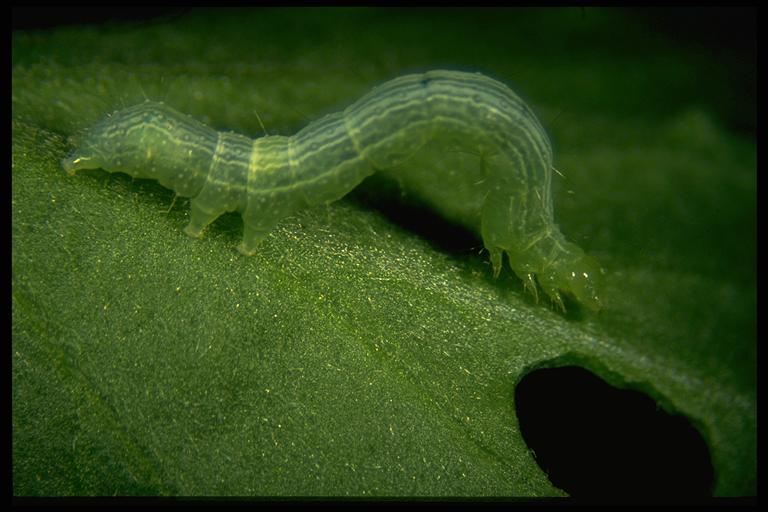
Cabbage looper, Trichoplusia ni (Hübner) (Lepidoptera: Noctuidae). Photo by Drees.
Common Name: Cabbage looper
Scientific Name: Trichoplusia ni (Hübner)
Order: Lepidoptera
Description: The caterpillar (larva) grows to be about 2 inches long, is light green and has three pairs of “true” legs behind the head plus pairs of fleshy “false legs” (prolegs) on the 3rd, 4th and last or 6th segments behind the segment with the last pair of true legs (the abdominal segments). This arrangement of legs causes the caterpillar to crawl with a “looping” motion, similar to that of inchworms. Some specimens are marked with light stripes along the body. Adult moths are mottled grayish-brown with a 1 1/2 inch wingspan. Each forewing is marked near its center with a pair of characteristic silver markings: a spot and a mark resembling a “V” or and “8” with an open end.
Other looper species include the celery looper, Syngrapha falcifera (Kirby) and the soybean looper, Pseudoplusia includens (Walker). “Loopers” (Noctuidae) can be separated from “inchworms” (Geometridae) by the configuration of the “false legs” or proglegs. Inchworms (Lepidoptera: Geometridae) are missing the pairs on the 3rd, 4th, and 5th (abdominal) segments behind the segment containing the third pair of “true” legs, and have only two pairs of prolegs (on segments 6 and 10). Loopers have three pairs of prolegs; segments A5, A6 and A10. Most loopers are cryptically colored, however, a few like the single filament looper, Sudariophora acutalis Wlk. is brightly colored and ornamented with long filaments. The velvetbean caterpillar, Anticarsia gemmatalis Hübner (Lepidoptera: Noctuidae) also occurs on soybeans. Adult moths (1 ½ inch wingspan) are usually mottled ash gray to reddish-brown and marked with a diagonal black line. Females lay eggs singly on host plants.
Larvae grow up to 2 inches long, have five pairs of abdominal prolegs, and their coloration varies from all light green to dark brown with dark and light-colored stripes down the body. They develop through six stages (instars) before pupating. Development from egg to adult occurs in 31 to 46 days. Caterpillars feed on tender leaves, causing skeletonization and defoliation, with injury on soybean plants being most severe on the upper part of the plant. Host plants include primarily legumes such as alfalfa, cowpea, peanuts and soybeans. In the south, several generations can occur annually. They overwinter in the tropics and southern Florida.
Life Cycle: Winter is spent in the pupal stage inside of a cocoon attached by one side to the host plant material. Adults emerge in the spring, mate and fly to a suitable host plant. Eggs are smooth, light green and slightly flat. Within about 3 days, small caterpillars hatch from the eggs. During a period of about 4 weeks caterpillars feed and develop through several stages (instars) before spinning a silk cocoon in which they form a greenish to brownish 3/4 inch long pupa. Adults emerge in about 13 days unless they overwinter. Development from egg to adult can be completed in about 35 days. Four generations or more can be produced each year.
Habitat and Food Source(s), Damage: Caterpillars have chewing mouthparts. Adults have siphoning mouths. Cabbage loopers feed on leaves of a wide variety of plants, including beets, cabbage, carnation, cotton, kale, lettuce, nasturtium, parsley, peas, potato, soybeans, spinach, tomato. Injured leaves appear tattered, with irregularly shaped holes removed between major leaf veins. Adults are attracted to lights at night.
Pest Status: One of the most common caterpillars found in garden and bedding plants; medically harmless.
For additional information, contact your local Texas AgriLife Extension agent or search for other state Extension offices.
Literature: Bohmfalk et al. 1982; Metcalf et al. 1962.